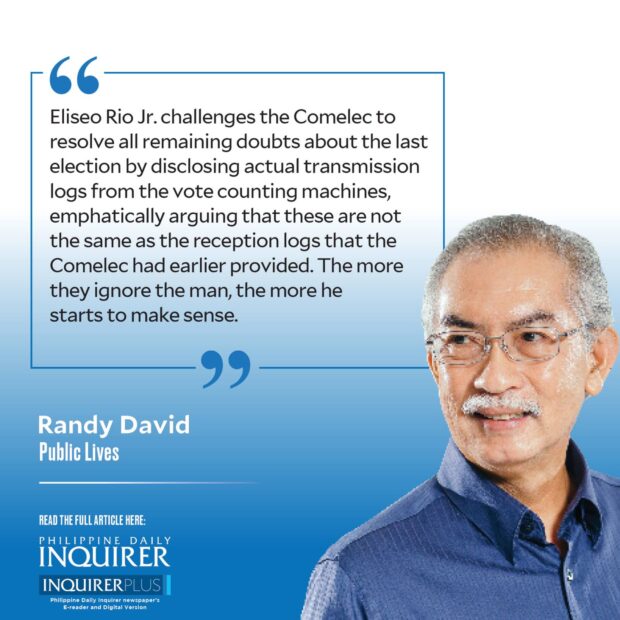Lingering doubts about the 2022 election
On May 9, 2022, the day the nation voted for its president, only 22,963 out of over 106,174 clustered precincts nationwide (or about 22 percent) had officially reported the end of voting as of 7 p.m. This was what election commissioner Marlon Casquejo told reporters at 7:35 that evening. Everyone prepared for a long night.
Yet, by 8:17 p.m., nearly 47 percent of all precincts not only had reported closing the polls, but had, in fact, already transmitted election results to the Commission on Elections’ (Comelec) transparency servers.
Article continues after this advertisementWhile pleasantly surprised by the lightning speed at which the results were being transmitted by the nation’s polling precincts, many were soon bothered by what they were seeing. Even as the results were presumably coming from various regions of the country, the distribution of the votes among the presidential candidates showed an unchanging lopsided pattern.
By 8:32 p.m., over 29 million votes, representing 53.5 percent of election returns, had already been tallied. Ferdinand Marcos Jr. had garnered at that point over 17.5 million, or 60 percent of the votes—a share so large as to completely eclipse the combined votes of all his rivals. By 11:40 p.m., the figures on the screen showed Marcos with 25 million votes as of 11:02 p.m., far ahead of his closest rival Leni Robredo with 11.9 million votes. Analysts quickly concluded that the voting trend they were seeing was but a mirror image of the major pre-election polls in the closing months of the presidential campaign.
In the past, the correspondence between pre-election survey results and actual election returns was considered concrete proof of the increasing accuracy of polling techniques and their predictive power. Today, it is employed as unassailable confirmation of the truthfulness of election results. The irony is inescapable.
Article continues after this advertisementBut, in those first hours after the end of the voting on May 9, whatever doubts Filipinos had about the veracity of the results being flashed on their television screens would have been quickly dashed by the electronic wizardry behind the deluge of election returns. They would have been dazzled not only by the speed at which the votes were read and counted (by machines) but also by the swiftness with which precinct-level election returns were being aggregated at the national level.
Later in the night, after more than 90 percent of the precinct returns had been accounted for, a few began to ask, as though waking up from a nightmare, what was happening. Were these transmissions real? No one could offer plausible answers. Political analysts were busy providing ex post facto explanations for Marcos’ looming landslide win and offering theoretical constructs of the average Filipino voter.
But one person entertained grave doubts about the entire manner in which precinct-level returns were transmitted, and doggedly pursued them. Retired brigadier general and electronics engineer Eliseo Rio Jr. was convinced that the results had been manipulated. A former acting secretary of the Department of Information and Communications Technology, Rio took a close look at the reception logs at the Comelec server and wondered how these were possible.It would normally take about half an hour at least, after the 7 p.m. closing of the polls, for the board of election inspectors at every precinct to complete nine tasks, including prompting the machines to print eight copies of the election returns, before they transmit these to the Comelec servers. Yet, within just one-and-a-half hours after the end of the voting, the nation’s precincts had already transmitted more than 53 percent of the election returns.
How was this possible? Rio thinks many election returns were transmitted to the Comelec server even before printed copies of these had been made. This he was able to confirm by comparing the time at which the Comelec server received them with the time stamped on the printed copies given to designated election watchers. In some instances, Rio shows, election returns were transmitted to the Comelec server more than an hour before they were actually printed. By itself, this may not prove large-scale or concerted manipulation. It may just show variations in the sequence in which election inspectors perform their tasks.The more important question, Rio says, is why the bulk of election returns were transmitted not through the country’s telcos like PLDT/Smart or Globe but through an unknown internet protocol address (IP 192.168.0.2). Rio thinks the latter is an unlawful “man-in-the-middle or intervening router/server.”
This mysterious IP address, Rio explains, surfaced after his team of digital forensics experts crosschecked what seemed like “raw files” that an insider uploaded on the Comelec website against the reception logs provided by the Comelec. Rio challenges the Comelec to resolve all remaining doubts about the last election by disclosing actual transmission logs from the vote counting machines, emphatically arguing that these are not the same as the reception logs that the Comelec had earlier provided.
The more they ignore the man, the more he starts to make sense.
—————-

















